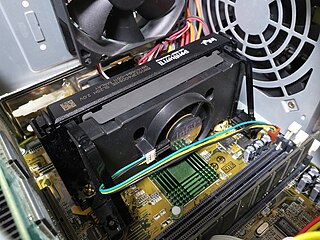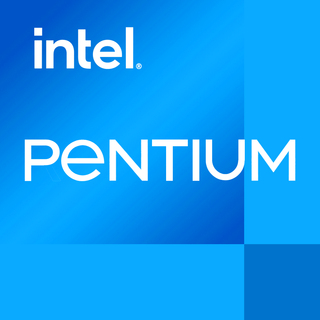The Pentium II is a sixth-generation CPU from Intel targeted at the consumer market.
The Pentium II is a sixth-generation CPU from Intel targeted at the consumer market.
| Model | Clock rate | L2 cache | FSB | Mult. | Voltage | TDP | Socket | Release date | Release price (USD) |
|---|---|---|---|---|---|---|---|---|---|
| Pentium II 233 | 233 MHz | 512 KB | 66 MT/s | 3.5× | 2.8 V | 34.8 W | May 7, 1997 | $636 | |
| Pentium II 266 [3] [4] | 267 MHz | 512 KB | 66 MT/s | 4× | 2.8 V | 38.2 W |
| May 7, 1997 | $775 |
| Pentium II 300 [7] [8] | 300 MHz | 512 KB | 66 MT/s | 4.5× | 2.8 V | 43 W |
| May 7, 1997 | $1981 |
| Model | Clock rate | L2 cache | FSB | Mult. | Voltage | TDP | Socket | Release date | Release price (USD) |
|---|---|---|---|---|---|---|---|---|---|
| Pentium II 266 | 267 MHz | 512 KB | 66 MT/s | 4× | 2.0 V | 16.8 W | January 26, 1998 [9] | ||
| Pentium II 300 | 300 MHz | 512 KB | 66 MT/s | 4.5× | 2.0 V | 18.6 W |
| January 26, 1998 [9] | |
| Pentium II 333 | 333 MHz | 512 KB | 66 MT/s | 5× | 2.0 V | 20.6 W |
| January 26, 1998 [9] | $722 |
| Pentium II Overdrive [12] [13] | 333 MHz | 512 KB | 66 MT/s | 5× | 3.3 V | August 10, 1998 | $599 | ||
| Pentium II 350 | 350 MHz | 512 KB | 100 MT/s | 3.5× | 2.0 V | 21.5 W |
| April 15, 1998 [14] | $621 |
| Pentium II 400 | 400 MHz | 512 KB | 100 MT/s | 4× | 2.0 V | 24.3 W |
| April 15, 1998 [14] | $824 |
| Pentium II 450 | 450 MHz | 512 KB | 100 MT/s | 4.5× | 2.0 V | 27.1 W |
| August 24, 1998 [15] | $669 |
| Model | Clock rate | L2 cache | FSB | Mult. | Voltage | TDP | Socket | Release date | Release price (USD) |
|---|---|---|---|---|---|---|---|---|---|
| Mobile Pentium II 233 | 233 MHz | 512 KB | 66 MT/s | 3.5× | 1.6 V | 9.0 W | April 2, 1998 | $542 | |
| Mobile Pentium II 266 | 267 MHz | 512 KB | 66 MT/s | 4× | 1.6 V | 10.3 W |
| April 2, 1998 | $772 |
| Mobile Pentium II 300 | 300 MHz | 512 KB | 66 MT/s | 4.5× | 1.6 V | 11.1 W |
| September 9, 1998 | $710 |
| Model | Clock rate | L2 cache | FSB | Mult. | Voltage | TDP | Socket | Release date | Release price (USD) |
|---|---|---|---|---|---|---|---|---|---|
| Mobile Pentium II 266PE | 267 MHz | 256 KB | 66 MT/s | 4× | 1.6 V | 10.3 W | January 25, 1999 | $187 | |
| Mobile Pentium II 300PE | 300 MHz | 256 KB | 66 MT/s | 4.5× | 1.6 V | 11.6 W |
| January 25, 1999 | $321 |
| Mobile Pentium II 333 | 333 MHz | 256 KB | 66 MT/s | 5× | 1.6 V | 11.8 W |
| January 25, 1999 | $465 |
| Mobile Pentium II 366 | 367 MHz | 256 KB | 66 MT/s | 5.5× | 1.6 V | 13.1 W |
| January 25, 1999 | $696 |
| Mobile Pentium II 400 | 400 MHz | 256 KB | 66 MT/s | 6× | 1.55 or 1.50 [16] V | 13.1 W |
| June 14, 1999 | $530 |

Athlon is the brand name applied to a series of x86-compatible microprocessors designed and manufactured by AMD. The original Athlon was the first seventh-generation x86 processor and the first desktop processor to reach speeds of one gigahertz (GHz). It made its debut as AMD's high-end processor brand on June 23, 1999. Over the years AMD has used the Athlon name with the 64-bit Athlon 64 architecture, the Athlon II, and Accelerated Processing Unit (APU) chips targeting the Socket AM1 desktop SoC architecture, and Socket AM4 Zen microarchitecture. The modern Zen-based Athlon with a Radeon Graphics processor was introduced in 2019 as AMD's highest-performance entry-level processor.

The K6 microprocessor was launched by AMD in 1997. The main advantage of this particular microprocessor is that it was designed to fit into existing desktop designs for Pentium-branded CPUs. It was marketed as a product that could perform as well as its Intel Pentium II equivalent but at a significantly lower price. The K6 had a considerable impact on the PC market and presented Intel with serious competition.

Duron is a line of budget x86-compatible microprocessors manufactured by AMD. Released on June 19, 2000 as a lower-cost offering to complement AMD's then mainstream performance Athlon processor line, it also competed with rival chipmaker Intel's Pentium III and Celeron processor offerings. The Duron brand name was retired in 2004, succeeded by the Sempron line of processors as AMD's budget offering.

Celeron is a series of low-end IA-32 and x86-64 computer microprocessor models targeted at low-cost personal computers, manufactured by Intel. The first Celeron-branded CPU was introduced in April 15, 1998, and was based on the Pentium II.

Cyrix Corporation was a microprocessor developer that was founded in 1988 in Richardson, Texas, as a specialist supplier of floating point units for 286 and 386 microprocessors. The company was founded by Tom Brightman and Jerry Rogers.

The Pentium II brand refers to Intel's sixth-generation microarchitecture ("P6") and x86-compatible microprocessors introduced on May 7, 1997. Containing 7.5 million transistors, the Pentium II featured an improved version of the first P6-generation core of the Pentium Pro, which contained 5.5 million transistors. However, its L2 cache subsystem was a downgrade when compared to the Pentium Pros. It is a single-core microprocessor.

The Pentium Pro is a sixth-generation x86 microprocessor developed and manufactured by Intel and introduced on November 1, 1995. It introduced the P6 microarchitecture and was originally intended to replace the original Pentium in a full range of applications. While the Pentium and Pentium MMX had 3.1 and 4.5 million transistors, respectively, the Pentium Pro contained 5.5 million transistors. Later, it was reduced to a more narrow role as a server and high-end desktop processor and was used in supercomputers like ASCI Red, the first computer to reach the trillion floating point operations per second (teraFLOPS) performance mark. The Pentium Pro was capable of both dual- and quad-processor configurations. It only came in one form factor, the relatively large rectangular Socket 8. The Pentium Pro was succeeded by the Pentium II Xeon in 1998.
The Pentium OverDrive was a microprocessor marketing brand name used by Intel, to cover a variety of consumer upgrade products sold in the mid-1990s. It was originally released for 486 motherboards, and later some Pentium sockets. Intel dropped the brand, as it failed to appeal to corporate buyers, and discouraged new system sales.

The Athlon 64 is a ninth-generation, AMD64-architecture microprocessor produced by Advanced Micro Devices (AMD), released on September 23, 2003. It is the third processor to bear the name Athlon, and the immediate successor to the Athlon XP. The second processor to implement the AMD64 architecture and the first 64-bit processor targeted at the average consumer, it was AMD's primary consumer CPU, and primarily competed with Intel's Pentium 4, especially the Prescott and Cedar Mill core revisions. It is AMD's first K8, eighth-generation processor core for desktop and mobile computers. Despite being natively 64-bit, the AMD64 architecture is backward-compatible with 32-bit x86 instructions. Athlon 64s have been produced for Socket 754, Socket 939, Socket 940, and Socket AM2. The line was succeeded by the dual-core Athlon 64 X2 and Athlon X2 lines.

The K6-2 is an x86 microprocessor introduced by AMD on May 28, 1998, and available in speeds ranging from 266 to 550 MHz. An enhancement of the original K6, the K6-2 introduced AMD's 3DNow! SIMD instruction set, featured a larger 64 KiB Level 1 cache, and an upgraded system-bus interface called Super Socket 7, which was backward compatible with older Socket 7 motherboards. It was manufactured using a 0.25 micrometre process, ran at 2.2 volts, and had 9.3 million transistors.

The K6-III was an x86 microprocessor line manufactured by AMD that launched on February 22, 1999. The launch consisted of both 400 and 450 MHz models and was based on the preceding K6-2 architecture. Its improved 256 KB on-chip L2 cache gave it significant improvements in system performance over its predecessor the K6-2. The K6-III was the last processor officially released for desktop Socket 7 systems, however later mobile K6-III+ and K6-2+ processors could be run unofficially in certain socket 7 motherboards if an updated BIOS was made available for a given board. The Pentium III processor from Intel launched 6 days later.

Slot 1 refers to the physical and electrical specification for the connector used by some of Intel's microprocessors, including the Pentium Pro, Celeron, Pentium II and the Pentium III. Both single and dual processor configurations were implemented.
The P6 microarchitecture is the sixth-generation Intel x86 microarchitecture, implemented by the Pentium Pro microprocessor that was introduced in November 1995. It is frequently referred to as i686. It was planned to be succeeded by the NetBurst microarchitecture used by the Pentium 4 in 2000, but was revived for the Pentium M line of microprocessors. The successor to the Pentium M variant of the P6 microarchitecture is the Core microarchitecture which in turn is also derived from P6.

Pentium is a series of x86 architecture-compatible microprocessors produced by Intel. The original Pentium was first released on March 22, 1993.